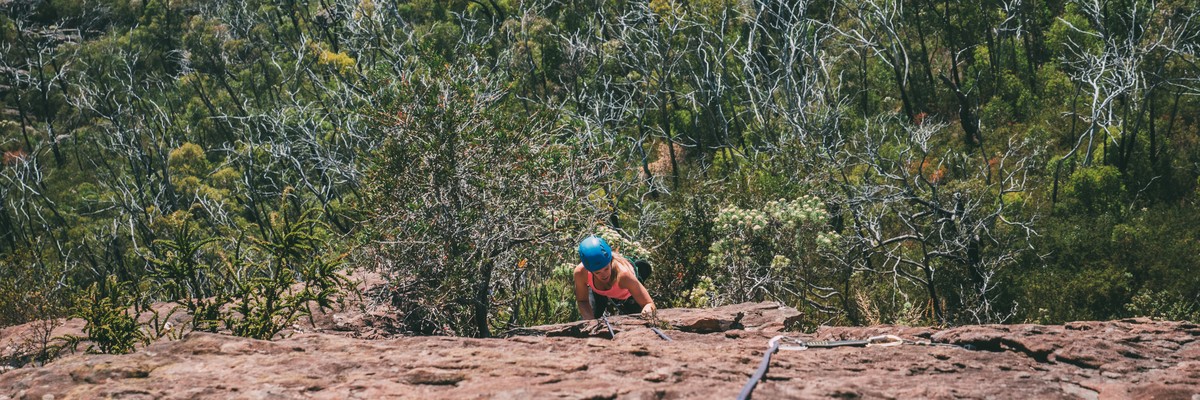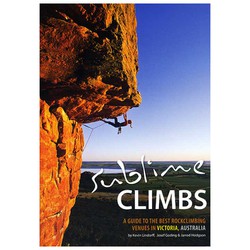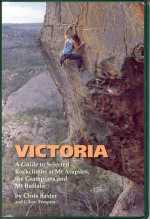Seasonality
Description
North Jawbone (singular!) overlooks the Cathedral Valley on the eastern side of the Cathedral Range. Despite its steep appearance North Jawbone is a reclining slab of about 60 degrees. The climbs are over 100m long on quality chocolate sandstone.
Approach
Access: From Melbourne take the Maroondah Highway to Buxton (100km). From Buxton continue along highway for 9km, and then turn right onto Cathedral Lane. Follow the road to the Cathedral State Park. Once inside the State Park, drive to the Cooks Mill camping site and continue on until you arrive at the North Jawbone car park.
From the car park take the well signed North Jawbone Hiking Track, down to the creek and on up the ridge on the other side of the valley. About half way up a bunch of slabby buttresses appear on the right (almost reaching the trail) A short distance further, there is a boulder marked by an orange triangle on the left.
Continue past this boulder to a second boulder marked by an orange triangle (https://www.thecrag.com/en/photo/7519436385). At the second boulder, immediately turn right off the hiking track and onto a small trail leading right. Follow the trail uphill marked by cairns through dense scrub, exiting at the base of the cliff. (If you cross a stream and hit switchback steps, you've gone too far)
Abseil Descent: The route follows the left edge of the right (Spiegal's Xanthene etc) buttress as marked. The rappels are approx 55 and 56m so the ground can be reached in two raps with 2x60m ropes (see notes below for options with shorter ropes).
First rap is two SS Petzl rings located a small scramble down from near the top of Travellers Slab.
Head down and slightly left to reach the ledges, go over these and down the face about 8m further to two more rings at a small but comfortable stance.
From here, the second rap heads slightly right down the face (near Route Two) to the bottom.
Options: If you have 1x60m and 1x50m ropes, you might be able to reach the midstation by equalising the ropes as best you can. Otherwise, stop on a small stance on the face and downclimb the easy but exposed face (or belay to be safer). Don't forget to tie stopper knots in the ends of your ropes. You can reach easy-angled slabs at the base with this rope combination and scramble down the last 2-3m of low-angle slabs.
If you only have 2x50m ropes you might still consider using the rap descent. Rap down to the ledges then belay or scramble down to the rings. For the second rap, head straight down the face over roofs (watch for sharp edges) to end up reaching a stance higher up in the gully, then bash down the last few metres.
Caveat: the short-rope options have not been tested. Abseiling can lead to injury or death, take suitable precautions.
Walk off: If you have packed light and lugged all your stuff up the cliff then walk off is quite simple. Scramble all the way up until you hit the tourist trail clearly marked by orange triangles. This heads off over the back of the cliff then down to the left. Trail passes through a grassy section, then head left towards the farmyard (signed) and down the hill. Allow just under an hour back to the car or 30/40 if you're fast.
Tags
Plan your Trip
Hello!
First time here?
theCrag.com is a free guide for rock climbing areas all over the world, collaboratively edited by keen rock climbers, boulderers and other nice folks.You can log all your routes, connect and chat with other climbers and much more...» go exploring, » learn more or » ask us a questionSelected Guidebooks more Hide
Author(s): Lindorff, Goding & Hodgson
Date: 2011
ISBN: 9780646529387
Get ready to fully experience the rock climbing scene in Victoria with Sublime Climbs, a comprehensive guidebook authored by Kevin Lindorff, Josef Goding, and Jarrod Hodgson. This full-color, 380-page book covers the best climbing locations in the region, including Mt Arapiles, Mt Buffalo, and the Grampians. It features descriptions of over 700 routes, topographic maps, and breathtaking images. Whether you're a seasoned pro or new to the sport, Sublime Climbs has everything you need to make the most of your climbing experience in Victoria and experience all of it's classic routes.
Author(s): Chris Baxter & Glenn Tempest
Date: 1994
ISBN: 0646167308
A Guide to selected rockclimbs at Mt Arapiles,the Grampians and Mt Buffalo
Accommodations nearby more Hide
Share this
Photos Browse all photos
/d1/92/d1924e4e41add82e9a51995953fc3d3d1e51603e)
★★★ Speigal's Overhang 10 - 2B5E851A-71A9-4F90-B9C9-E969C9B5C680.jpeg

★★★ Speigal's Overhang 10 - image-1567301319991.png

North Jawbone - Start of trail to crag

Vaughan on ★★★ Speigal's Overhang 10 - PXL_20230411_011405241.MP.jpg
Get a detailed insight with a timeline showing
- Ticks by climbers like you
- Discussions of the community
- Updates to the index by our users
- and many more things.
Login to see the timeline!



